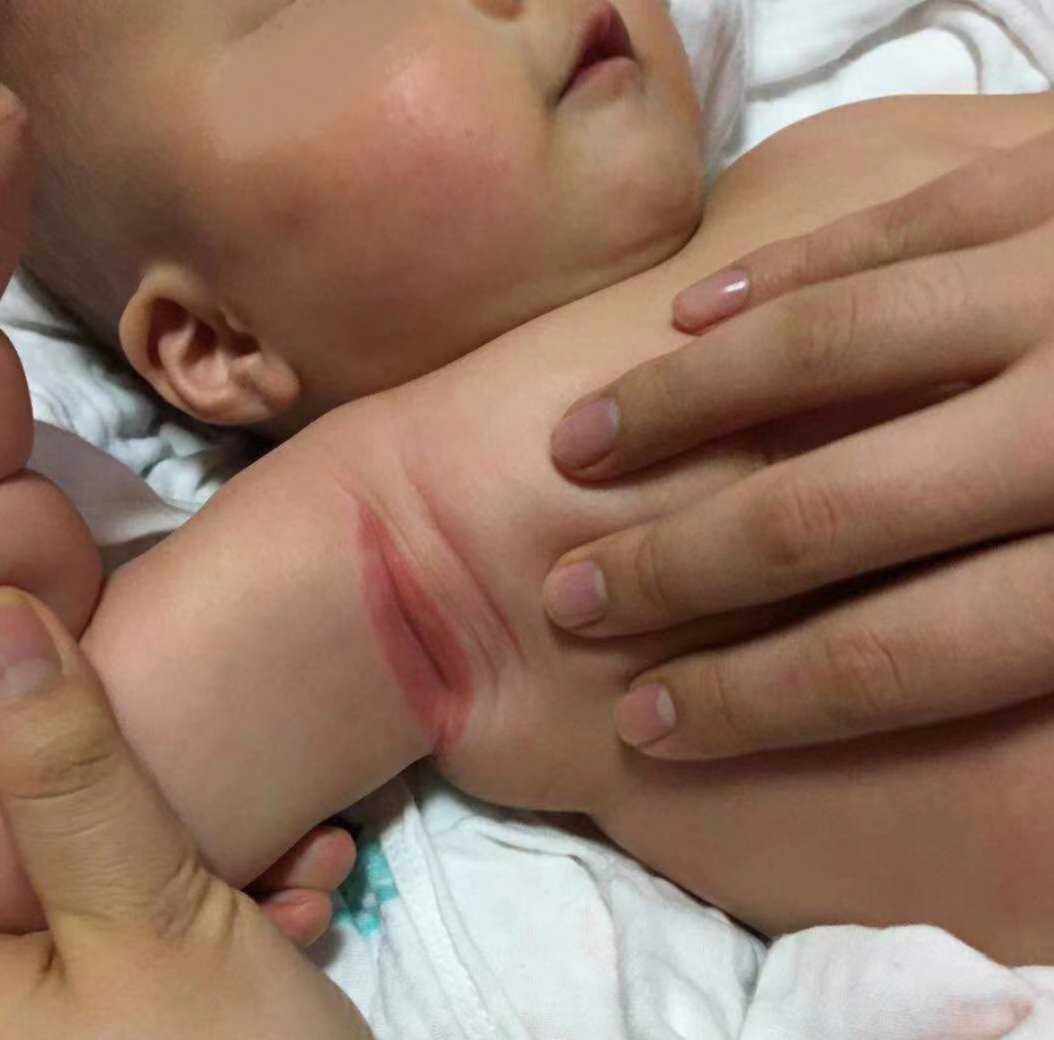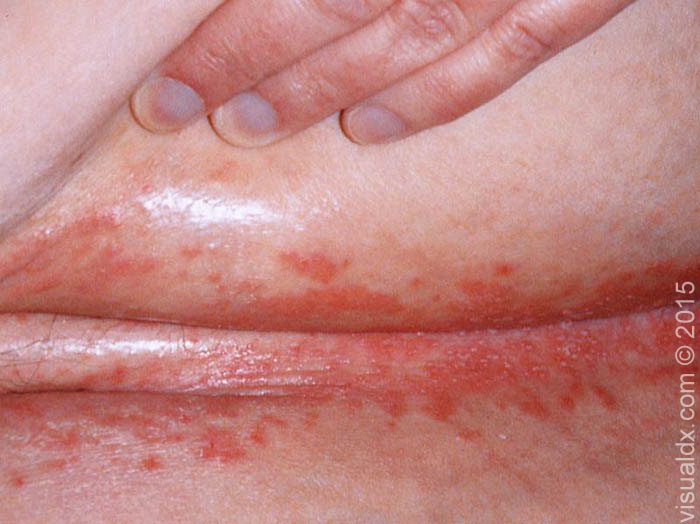Intertrigo
OVERVIEW
What is intertrigo?
Intertrigo, also known as friction erythema, chafing, or erythema intertrigo, commonly referred to as sweat rash, is a superficial inflammation caused by warmth, moisture, and friction in skin folds. It most frequently occurs during hot and humid seasons, appearing between closely apposed skin surfaces, primarily affecting obese individuals and infants, though children and the elderly are also susceptible.
Prolonged or recurrent cases may lead to secondary bacterial or fungal infections. Targeted treatment addressing the underlying cause, along with local skin isolation and care to reduce warmth, moisture, and friction, can lead to complete recovery without adverse effects.
SYMPTOMS
What are the manifestations of intertrigo?
In the early stage, the rash often appears as a well-defined localized bright red or dark red patch (Figure 1). It may gradually worsen, presenting with papules, vesicular papules, pustular papules, maceration, erosion, exudation, or even superficial ulcers. It is accompanied by itching, burning, or pain.

(Figure 1 source: Collected clinically by the author)
Erythematous satellite papules and small white pustules (Figure 2) indicate secondary fungal (Candida) infection, which may lead to white skin fissures after drying.

(Figure 2 source: UpToDate Clinical Advisor)
For cases with secondary bacterial infection, there may be 1–3 mm yellow pustules or larger, fragile honey-colored pustules, along with signs of erosion, crusting, and pain.
Under what circumstances is intertrigo prone to occur?
- Clinically, it is more common in obese individuals and infants, as well as in children and the elderly.
- It often occurs during hot and humid summer weather.
- It tends to affect friction-prone, moist skin folds, such as behind the ears, upper eyelid folds, neck, armpits, under the breasts, around the navel, groin, elbow creases, popliteal fossa, perianal area, and between fingers and toes.
CAUSES
What are the causes of intertrigo?
It primarily occurs due to friction between skin folds combined with warmth and moisture (sweat, urine, feces, etc.), leading to redness and maceration. Friction between moist skin causes maceration and damage to the stratum corneum, while maceration further increases frictional skin damage, thereby impairing the skin's barrier function. Subsequently, the altered skin barrier enhances microbial permeability, making secondary bacterial or fungal infections more likely.
- Candidal intertrigo most commonly occurs under the breasts of obese women, and the groin is also frequently infected by fungi (yeast or dermatophytes), often presenting with satellite papular lesions (Figure 2).
- Bacterial infections may involve pathogens such as streptococci, staphylococci, pseudomonas, or corynebacteria. Streptococcal intertrigo often affects the neck, armpits, and groin in children, manifesting as well-defined, fiery red, moist, shiny, foul-smelling lesions without satellite papules.
DIAGNOSIS
How to diagnose intertrigo?
It can be clinically diagnosed based on typical skin lesion characteristics (erythema, moisture) and common sites (limited to skin folds).
What diseases should intertrigo be differentiated from?
- Candidal dermatitis: The rash is not limited to skin folds, with scattered round, flat-topped red papules on surrounding skin, often accompanied by annular scales. Fungal microscopy of scales may reveal hyphae or spores.
- Eczema: Ill-defined borders, lesions not confined to skin folds, more generalized and symmetrically distributed. Polymorphic rashes such as erythema, papules, and vesicles may appear, with obvious exudation, unclear boundaries, frequent recurrence, and intense itching.
- Inverse psoriasis: In addition to skin folds, typical psoriatic rashes may appear on the trunk and extensor surfaces of limbs.
What tests are needed for intertrigo?
Clinical diagnosis is usually sufficient, and early-stage cases generally do not require testing.
- If fungal infection is suspected, fungal smear examination or Wood's lamp examination may be performed.
- If bacterial infection is suspected, pustule smear staining or bacterial culture can confirm the diagnosis.
TREATMENT
What department should I see for intertrigo?
Dermatology, Pediatrics.
How to treat intertrigo?
- Take frequent baths, avoid irritation from soap and hot water, and keep the skin in folds clean and dry.
- Separate the opposing skin surfaces with dry gauze, cotton cloth, or other suitable dressings.
- In the early erythema stage, calamine lotion can be used. If erosion or exudation has occurred, zinc oxide paste, 0.9% sodium chloride solution, or 0.1% ethacridine solution can be used for wet compresses. After drying, switch to creams or ointments, such as petroleum jelly.
- Topical low-potency corticosteroids and tacrolimus can help reduce inflammation, but it is recommended to combine them with antifungal medications or topical antibiotics.
- If secondary infection occurs, use topical antifungal preparations for fungal infections and topical antibiotic ointments for bacterial infections.
How to care for and treat intertrigo in children?
- Dryness + isolation is key.
- Bathe frequently, using mild baby cleansers to avoid irritation from soap and hot water. Then, dry the rash area with a hairdryer in a cool environment and ensure proper ventilation to keep the skin in folds clean and dry.
- Use absorbent materials (such as gauze, cotton cloth, or fragrance-free baby wipes) to separate the folds.
- Apply barrier creams like petroleum jelly to rash areas exposed to sweat, urine, or feces. Minimize sweating, and overweight babies should focus on weight control.
- In the early erythema stage, calamine lotion, zinc oxide ointment, or diaper rash cream can be used.
- If local erosion, exudation, or oozing occurs, apply cool wet compresses with 0.9% sodium chloride solution, 0.1% ethacridine solution, or other wet compress medications. Cover the rash with gauze soaked in the solution, 2–3 times daily for 10 minutes each time.
- If local itching or discomfort is significant, low-potency topical corticosteroid creams (e.g., hydrocortisone acetate cream, Desonide, or Eurax) can be used to reduce inflammation and relieve itching. It is recommended to combine them with antifungal creams like clotrimazole cream.
- For bacterial infections, use antibiotic ointments like mupirocin ointment for 3–7 days. For fungal infections, use antifungal creams like clotrimazole cream for 2–4 weeks.
DIET & LIFESTYLE
What should be paid attention to in daily life for intertrigo?
- Maintain a healthy lifestyle, avoid smoking; exercise regularly, avoid prolonged sitting, and prevent overweight and obesity.
- Exercise 3 to 5 times a week, about 30 minutes each session, combining aerobic and strength training with moderate intensity and avoiding overexertion.
- In hot weather, use air conditioning, fans, or ventilation to lower environmental and body temperature and reduce sweating.
- For overweight infants, encourage more gross motor activities to increase energy expenditure. For intertrigo in the neck area, allow the baby to spend more time on their stomach while awake to expose and ventilate the folded skin, which can alleviate symptoms.
- Ensure adequate sleep daily and correct poor sleep habits.
- Maintain skin cleanliness and hygiene.
Are there any dietary restrictions for intertrigo?
There are no specific dietary restrictions; a healthy and balanced diet is sufficient.
- When cooking, use less salt, oil, and high-sodium seasonings, and avoid pickled vegetables and meats.
- Do not rely solely on refined grains; replace some staples with whole grains, legumes, potatoes, or pumpkin.
- Balance meat and vegetables, prioritizing white meats like chicken, duck, and fish, while limiting fatty meats. Eggs and milk are important sources of protein and other nutrients.
- For vegetarians, consume more beans and bean products to supplement protein.
- Eat plenty of fruits and vegetables.
- Avoid alcohol as much as possible.
PREVENTION
Can intertrigo be prevented?
Yes.
- Take frequent showers, avoid soap irritation, and keep the skin clean and dry.
- Maintain a suitable room temperature to minimize sweating and reduce moisture in skin folds.
- For infants, promptly clean and dry sweaty areas, change diapers frequently, and maintain hygiene.
- Exercise regularly to improve physical fitness and reduce obesity.
- For areas prone to intertrigo, apply moisturizer or barrier cream routinely 2–6 times daily or more.
